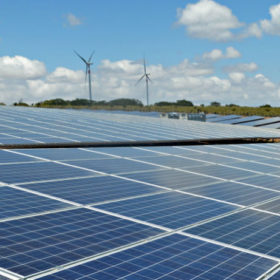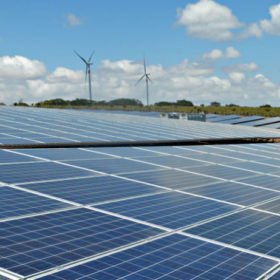India to add about 15 GW of wind-solar hybrid capacity in five years

Almost 10 GW of wind-solar hybrid capacity is already under implementation in the country which has only 100 MW of such capacity installed at present, according to Crisil.
Wind-solar hybrid plants—which have found favours globally—are becoming the preferred renewable energy (RE) option in India, too, with strong support from Solar Energy Corporation of India and several state governments.
Around 15 GW of wind-solar hybrid capacity will come up in India over the next five years, compared with only 100 MW today. Of this, 10 GW is already under implementation – either under construction or being tendered – and will start feeding the grid by 2024, according to a report by Crisil.
Co-locating solar and wind plants reduces the variability of generation and improves grid security, thereby overcoming discoms’ reluctance to offtake renewable power. Also, for developers, such plants could result in a higher capacity utilisation factor (CUF), even if they don’t get the optimal generation sites in terms of irradiance and high wind speeds.
Challenges
Pricing will be key to the success of wind-solar hybrid projects, said Crisil analysts who estimate wind-solar hybrid power tariffs to fall in the range of Rs 2.8-2.9 per kWh with a wind-heavy configuration.
The Rs 2.8-2.9 per kWh tariff of hybrid projects is higher than the solar tariff, which has dropped to Rs 2.5 per kWh in recent bids, and comparable to wind tariff of Rs 2.80-2.85 per kWh.
“The tariff [for hybrid projects] can be brought down by another 10 paisa per kWh if the co-location clause (necessitating the wind and solar components to be located at the same place) is removed,” stated the analysts.
In the case of ‘wind-solar’ hybrid-with-storage projects, Crisil Research believes the weighted average tariff (peak and off-peak) of Rs 4.04- 4.30 per kWh, as discovered in recent auctions, is competitive with thermal power tariffs of Rs 4.4 per kWh.
The agency highlighted lack of suitable sites with strong irradiation and high wind speeds, adequate transmission infrastructure and technical issues such as grid balancing, in addition to tariffs, as the key challenges to hybrid projects.
Pipeline
India had installed 37.69 GW of standalone wind energy capacity and 35 GW of solar capacity as of March 31, 2020.
Currently, there are proposals to set up 3.9 GW of pure-play hybrid projects, and another 4.5 GW of hybrid projects with energy storage systems. Besides, 1.1 GW of hybrid projects are expected to come up as part of the 5.4 GW that will be developed under the round-the-clock (RTC) scheme, which mandates a 51:49 blend of renewable and thermal.
“Since wind-solar hybrid projects with energy storage systems (ESS) can cater to peak and RTC power demand, they can reduce the country’s dependence on gas-based and pumped hydro-based peaking plants. They can also improve the role of RE in providing grid ancillary services on the generation side. Moreover, they can spur ESS demand by building an effective storage ecosystem,” said the analysts.


